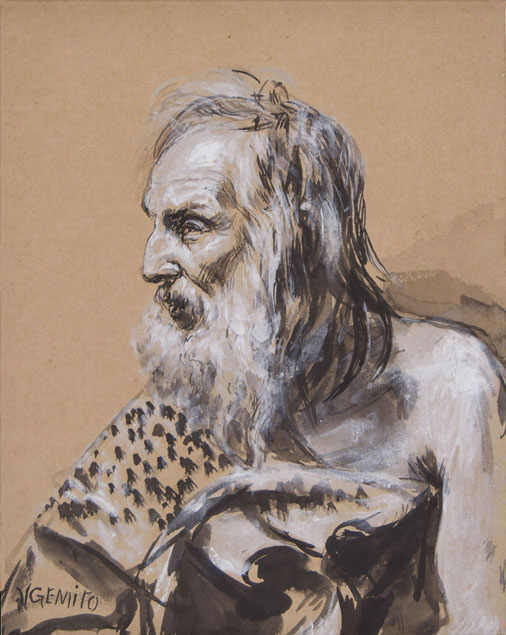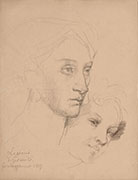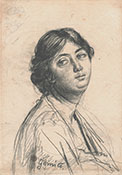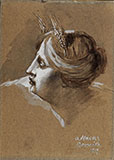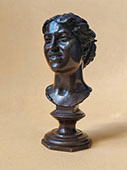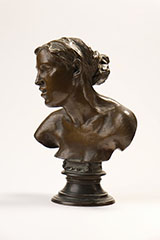(Naples 1852 - 1929)
PORTRAIT OF MASTO CICCIO AS WINTER
Brush, black ink, heightened with white, over traces in black chalk. 180 x 225 mm. Signed V GEMITO in black ink at bottom left.
PROVENANCE: Galleria la Persiana, Palermo. See the label on the back of the frame.
This drawing, unpublished, relates to a pair of sculptures and two drawings. The two sculptures, both dated 1914, have been published in 1944; see A. Schettini, E. Somaré, Vincenzo Gemito, 1944; tav. 45 and 46. The current location of these works is unknown to me. Both sculptures, a original wax and a bronze, portray Masto Ciccio, Gemito's adoptive father, respectively as an allegory of Time and as an allegory of Winter Two other drawings related with the pair of sculptures and depicting Masto Ciccio as an allegory of Winter have been quite recently published in the catalogue of the Gemito exhibition in Villa Pignatelli, Naples, see D. M. Pagano, Gemito, Naples 2009, cat. no 42, p. 151. These two drawings are dated 1913 and 1914. The same dating we propose for our drawing.
Gemito's beloved adoptive father Francesco Jadicicco called Masto Ciccio had married Gemito's mother, Giuseppina Baratta, in 1875 when Gemito was 23 years old. Masto Ciccio played a prominent role in Gemito's life, offering constant support and friendship to the sculptor. He is often depicted in Gemito's drawings and worked for a period of time in Gemito's foundry.
Vincenzo Gemito, one of the premier Italian sculptors of the 19th century, was essentially self-taught. Discovered on the foundling hospital's doorstep and adopted by a poor artisan, Gemito got work in a sculptor's studio when he was a boy. In his youth, he worked for two local sculptors, Emanuele Caggiano and Stanislao Lista, but neither seems to have had much stylistic influence on him. Gemito's realistic representations of Neapolitan street life marked a dramatic shift from earlier artists' sentimentalizing. His sculpture was so immediately alive and strong that he became famous at a very early age. Gemito sold a statue to the city of Naples when he was sixteen years old; and he was only twenty-one years old when he was commissioned to model the portrait of Giuseppe Verdi. Gemito's Pescatorello (Neapolitan Fisherboy) brought him acclaim at the 1877 Paris Salon, and he stayed in Paris for three years.
Gemito was also an immensely gifted draughtsman. After completing an important public commission, the portrait of Charles V, in 1887, he suffered a mental collapse and gave up sculpture almost entirely: he withdrew to one room, concentrating on drawing and seeing few friends. Around 1909 Gemito resumed sculpting, incorporating Hellenistic influences into his work, inspired by the works of art that the diggings of Pompeii and Herculaneum had brought to light and which were exhibited in the Archeological Museum in Naples. His sculpture demonstrated a delicate sensitivity and detail that ultimately derived from his drawings.
